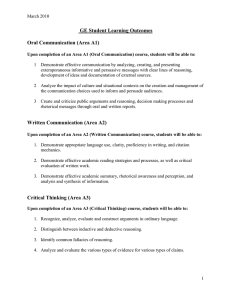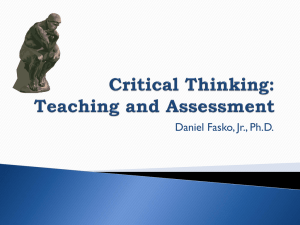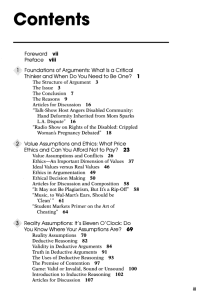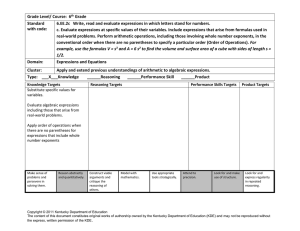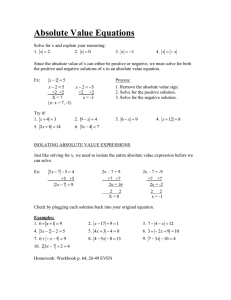Kelly 7/12/16 What knowledge about specific mathematical objects, representations, statements, procedures,
advertisement
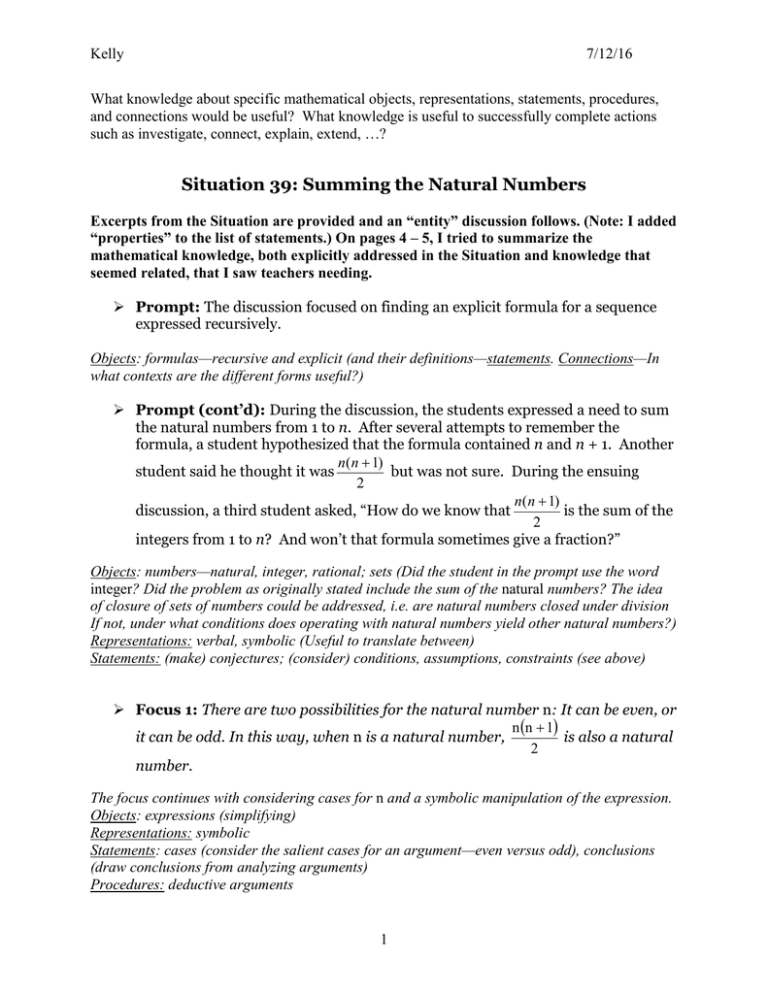
Kelly 7/12/16 What knowledge about specific mathematical objects, representations, statements, procedures, and connections would be useful? What knowledge is useful to successfully complete actions such as investigate, connect, explain, extend, …? Situation 39: Summing the Natural Numbers Excerpts from the Situation are provided and an “entity” discussion follows. (Note: I added “properties” to the list of statements.) On pages 4 – 5, I tried to summarize the mathematical knowledge, both explicitly addressed in the Situation and knowledge that seemed related, that I saw teachers needing. Prompt: The discussion focused on finding an explicit formula for a sequence expressed recursively. Objects: formulas—recursive and explicit (and their definitions—statements. Connections—In what contexts are the different forms useful?) Prompt (cont’d): During the discussion, the students expressed a need to sum the natural numbers from 1 to n. After several attempts to remember the formula, a student hypothesized that the formula contained n and n + 1. Another n(n 1) student said he thought it was but was not sure. During the ensuing 2 n(n 1) discussion, a third student asked, “How do we know that is the sum of the 2 integers from 1 to n? And won’t that formula sometimes give a fraction?” Objects: numbers—natural, integer, rational; sets (Did the student in the prompt use the word integer? Did the problem as originally stated include the sum of the natural numbers? The idea of closure of sets of numbers could be addressed, i.e. are natural numbers closed under division If not, under what conditions does operating with natural numbers yield other natural numbers?) Representations: verbal, symbolic (Useful to translate between) Statements: (make) conjectures; (consider) conditions, assumptions, constraints (see above) Focus 1: There are two possibilities for the natural number n: It can be even, or n n 1 it can be odd. In this way, when n is a natural number, is also a natural 2 number. The focus continues with considering cases for n and a symbolic manipulation of the expression. Objects: expressions (simplifying) Representations: symbolic Statements: cases (consider the salient cases for an argument—even versus odd), conclusions (draw conclusions from analyzing arguments) Procedures: deductive arguments 1 Kelly 7/12/16 Focus 2: Specific examples suggest a general formula for the sum of the first n natural numbers. Strategic choices for pair-wise grouping of numbers are critical to the development of the general formula. Objects: (recognize) patterns Representations: symbolic, models and diagrams (array of dots) Statements: cases, properties (commutative and associative), examples (use examples to investigate a new situation), conclusions Procedures: strategies (grouping numbers), deductive and inductive arguments Focus 3: Because the first n natural numbers form an arithmetic sequence, properties of such sequences can be used to find their sum. The terms of an arithmetic sequence have a kind of symmetry, and the difference between consecutive terms is constant. The commutative and associative properties of addition allow the terms to be regrouped so their sum can be calculated more efficiently. Objects: patterns (sequences; knowing that a common difference indicates an arithmetic sequence), expressions (for sum of first n natural numbers), formulas (developed for the sum of the first n natural numbers, for the sum of an arithmetic sequence) Representations: symbolic (symbolic manipulation of expressions, summation notation) Statements: properties (commutative and associative, equality, arithmetic sequences), conclusions Procedures: strategies (grouping, look for patterns, symmetry, ways to investigate new situation), deductive arguments Connections: history and culture (Gauss), studied earlier or later (arithmetic mean, sequence, series; connecting explicit formula for arithmetic sequence to equation of line and investigate the relationship between recursive formulas and characteristics of lines) Focus 4: Geometric arrays provide opportunities to derive the formula for the sum of the first n natural numbers. Objects: shapes (triangles and rectangles), expressions (for number of dots in rows and columns, for sum) Representations: models and diagrams (array of dots), geometric (triangular and rectangular arrays of dots), verbal Statements: cases (knowing that representations are different if n is even or odd and using in argument), language (arrays, columns and rows), conclusions Procedures: strategies (rearranging dots, duplicating array), deductive reasoning (knowing that deductive reasoning is generally more reliable than inductive) 2 Kelly 7/12/16 Focus 5: Decomposition and recomposition of plane geometric figures preserve area. Geometric figures provide opportunities to derive the formula for the sum of the first n natural numbers. Objects: expressions, formulas (area) Representations: verbal, symbolic, models and diagrams (staircase, triangular array of unit squares), geometric (triangular and rectangular) Statements: properties (of equality, including substitution) Procedures: strategies (decomposing and recomposing unit squares, duplicating staircase, completing array), deductive arguments, algorithms (calculating area) Connections: studied earlier (area) Focus 6: The principle of mathematical induction offers one method for verifying a formula for the sum of the terms in a sequence. Objects: expressions (multiple expressions for the sum of the first n natural numbers), formulas Representations: symbolic (summation notation, symbolic manipulation) Statements: conditions, assumptions, constraints (proving for all natural numbers), cases (part of proof by induction) Procedures: inductive arguments, various types of proof (knowing and illustrating the importance of the different aspects of proof by induction) Post-Commentary 1: The sum of the first n natural numbers is a specific case of the sum of the first kth powers of natural numbers. Objects: expressions Representations: verbal, symbolic (manipulation) Statements: properties (of equality, including substitution); conditions, assumptions, and constraints (generalizability of the process…) Procedures: deductive and inductive arguments, informal reasoning (?) Connections: history and culture (Pascal); inside mathematics (expansions of binomials using Pascal’s triangle; connections to combinations can also be made) Post-Commentary 2: Triangular numbers are a specific type of figurate number. I’ve listed what I believe would be useful in a discussion of figurate numbers. Objects: expressions, shapes, patterns Representations: verbal, geometric / models and diagrams, symbolic, algebraic Statements: examples and nonexamples, definitions, language (terminology), conjectures and conclusions Procedures: strategies, deductive and inductive arguments, informal reasoning, proof Connections: inside mathematics (sequences and series) 3 Kelly 7/12/16 Summary of MTTM for Situation 39 Mathematical Objects: Numbers: Number is an important concept in (1) understanding the task and (2) answering the second of the student’s questions. (1) Understanding the task of summing the natural numbers from 1 to n requires knowing the definition of a natural number. How are natural numbers different from integers, whole numbers, etc.? Could the problem be restated using a different set of numbers? If it were, in which case(s) would the answer be the same? Can the answer be found in every situation? (2) To answer the question of fractional answers, teachers must have number sense or at least be able to provide the different cases necessary to address the question. The student’s question raises the issue of closure of a set. Teachers need to understand when or under what conditions sets are closed. Shapes and Transformations: These are minor concepts in this Situation. Teachers must understand that triangles can be duplicated and rotated to form rectangles. Expressions and Equations: Creating and manipulating expressions are common themes throughout this Situation. Teachers should be able to determine an expression for a necessarily odd or even number and use those numbers in symbolic manipulation (Focus 1). Writing expressions, the ability to generalize, from patterns (as witnessed in diagrams, symbols, etc.) is also an essential skill. Teachers should understand why it is okay to add two equations together (properties of equality, etc.). Also, teachers should know that there are multiple ways to express the same quantity (explicitly, recursively, using summation notation, …). Patterns: Teachers should recognize patterns and generalize, if possible. In this Situation, a teacher should recognize the sum of the first n natural numbers as an arithmetic sequence. Also, teachers should recognize patterns in numbers and diagrams and be able to write an expression for those patterns, if possible. Formulas: Teachers should know formulas for area and the difference between recursive and explicit formulas. Teachers should also be able to convert between different types of formulas and make connections to mathematics learned previously or to be learned later, e.g. in what contexts is each type of formula useful? Teachers should know how to expand binomials of nth degree using the Binomial Theorem. Domain: Teachers should understand that different sets of numbers allow or restrict the conclusions one may make about a situation. (See above.) Representations: Teachers should be able to translate among different representations of a mathematical situation: verbal, symbolic, models and diagrams, graphs, and geometric. 4 Kelly 7/12/16 Statements: Teachers need to be able to make conjectures, consider appropriate cases, understand conditions under which particular rules (properties) hold, use examples to investigate new situations, know and use appropriate language, and be able to make and evaluate conclusions based on an analysis of the information. In this Situation, teachers should know that the two important cases for discussion are the cases for an even or odd number of terms. They should be able to make (and evaluate) conjectures about the different cases, use examples when needed, and reach conclusion based on solid reasoning and logic. If necessary, a teacher should be able to provide (or evaluate) a counterexample to a conjecture. This would most likely require deep knowledge of number concepts. Procedures: Teachers should develop strategies for investigating patterns or other situations. These strategies could include pairing or grouping numbers into interesting sets, looking for patterns in numbers, searching for symmetry, looking at consecutive differences, rearranging diagrams, duplicating figures, etc. Teachers should understand the difference among, validity of, usefulness of, and limitations of deductive and inductive arguments and informal reasoning. Teachers should know that inductive reasoning is not synonymous with proof by induction. Teachers should come to understand why deductive reasoning is usually more reliable than inductive reasoning. They should also see the merit of using informal reasoning to form and test conjectures. Teachers should be able to use various types of proof, not just as a way to prove something that is known but also as a way to generate new knowledge (Schoenfeld). From this Situation, teachers should know the steps to proof by induction and why the steps lead to a “proof” that the formula holds. Connections: Teachers should know the contexts in which “classic” problems originated. In terms of Situation 39, they should know both Gauss and Pascal’s approaches to determining this sum. They should be able to discuss the merits of each, including the generalizability to other sets of numbers. Teachers should have a firm view of the big picture of mathematics, especially school mathematics, discerning which topics students have seen or have developmental access to based on their backgrounds. Teachers should be able to connect mathematical topics to other contexts within mathematics and outside. In this Situation, teachers should be able to connect this topic to sequences and series and linear equations. 5

